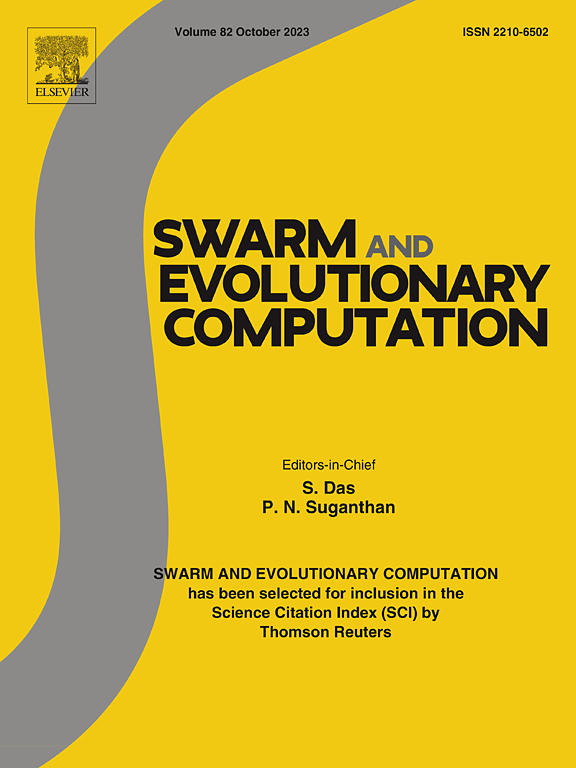A parameter-less decoupling strategic adjustments method for shape reconfiguration of UAV swarm
IF 8.5
1区 计算机科学
Q1 COMPUTER SCIENCE, ARTIFICIAL INTELLIGENCE
引用次数: 0
Abstract
Unmanned aerial vehicle (UAV) swarms need to efficiently reconfigure different 3D shapes to meet complex task requirements, such as those in agriculture, industry, and battlefield environments. This paper presents a novel parameter-less decoupling strategy adjustment method (PD-SAM) to enable 3D shape reconfiguration of fixed-wing UAV swarms. The PD-SAM includes an improved behavior-rule-based decision-making approach that decouples the decision process into two main components: motion trend adjustment and dynamic position adjustment. Unlike traditional behavior-rule-based methods that rely on weighted parameters for combination, the proposed method reduces the number of parameters and eliminates the need for parameter optimization. Additionally, a mapping mechanism is introduced to translate macroscopic shape parameters into microscopic parameters. By mapping preset swarm shape parameters to microscopic rule actions, this mechanism facilitates flexible and spontaneous swarm reconfiguration. This approach is independent of the UAV swarm size and exhibits high scalability, making it suitable for swarm reconfiguration across a wide range of swarm sizes. Finally, with the aim of validating the effectiveness of the proposed method, this study employs flight control models suitable for real-world flight experiments, alongside high-fidelity aircraft dynamics models. The proposed PD-SAM algorithm is tested through software in the loop simulation and compared with a classical behavior-rule-based approach DWAR (Dynamically Weighting Autonomous Rules), as well as a optimization-based method HPSOGA (Hybrid Particle Swarm Optimization and Genetic Algorithm). Simulation results validate that the proposed PD-SAM method reduces the average error by 74.44 % and the average standard deviation of the swarm motion trend by 51.83 % compared to the DWAR method during the swarm shape reconfiguration process. In terms of computational resource consumption, the PD-SAM method is 3 to 4 orders of magnitude lower than the HPSOGA method.
无人机群形重构的无参数解耦策略调整方法
无人机(UAV)群需要有效地重新配置不同的三维形状,以满足复杂的任务要求,如农业、工业和战场环境。提出了一种新的无参数解耦策略调整方法(PD-SAM),实现了固定翼无人机群的三维形状重构。PD-SAM包括一种改进的基于行为规则的决策方法,该方法将决策过程解耦为两个主要部分:运动趋势调整和动态位置调整。与传统的基于行为规则的方法依赖加权参数进行组合不同,该方法减少了参数的数量,省去了参数优化的需要。此外,还引入了一种映射机制,将宏观形状参数转化为微观参数。通过将预设的群体形状参数映射到微观规则动作,该机制促进了灵活和自发的群体重构。该方法与无人机群大小无关,具有较高的可扩展性,适用于大范围的群重构。最后,为了验证所提出方法的有效性,本研究采用了适合真实飞行实验的飞行控制模型,以及高保真飞机动力学模型。通过软件仿真对PD-SAM算法进行了验证,并与经典的基于行为规则的动态加权自治规则(DWAR)和基于优化的混合粒子群优化与遗传算法(HPSOGA)进行了比较。仿真结果表明,与DWAR方法相比,PD-SAM方法在群体形状重构过程中的平均误差降低了74.44%,群体运动趋势的平均标准差降低了51.83%。在计算资源消耗方面,PD-SAM方法比HPSOGA方法低3 ~ 4个数量级。
本文章由计算机程序翻译,如有差异,请以英文原文为准。
求助全文
约1分钟内获得全文
求助全文
来源期刊

Swarm and Evolutionary Computation
COMPUTER SCIENCE, ARTIFICIAL INTELLIGENCEC-COMPUTER SCIENCE, THEORY & METHODS
CiteScore
16.00
自引率
12.00%
发文量
169
期刊介绍:
Swarm and Evolutionary Computation is a pioneering peer-reviewed journal focused on the latest research and advancements in nature-inspired intelligent computation using swarm and evolutionary algorithms. It covers theoretical, experimental, and practical aspects of these paradigms and their hybrids, promoting interdisciplinary research. The journal prioritizes the publication of high-quality, original articles that push the boundaries of evolutionary computation and swarm intelligence. Additionally, it welcomes survey papers on current topics and novel applications. Topics of interest include but are not limited to: Genetic Algorithms, and Genetic Programming, Evolution Strategies, and Evolutionary Programming, Differential Evolution, Artificial Immune Systems, Particle Swarms, Ant Colony, Bacterial Foraging, Artificial Bees, Fireflies Algorithm, Harmony Search, Artificial Life, Digital Organisms, Estimation of Distribution Algorithms, Stochastic Diffusion Search, Quantum Computing, Nano Computing, Membrane Computing, Human-centric Computing, Hybridization of Algorithms, Memetic Computing, Autonomic Computing, Self-organizing systems, Combinatorial, Discrete, Binary, Constrained, Multi-objective, Multi-modal, Dynamic, and Large-scale Optimization.
 求助内容:
求助内容: 应助结果提醒方式:
应助结果提醒方式:


